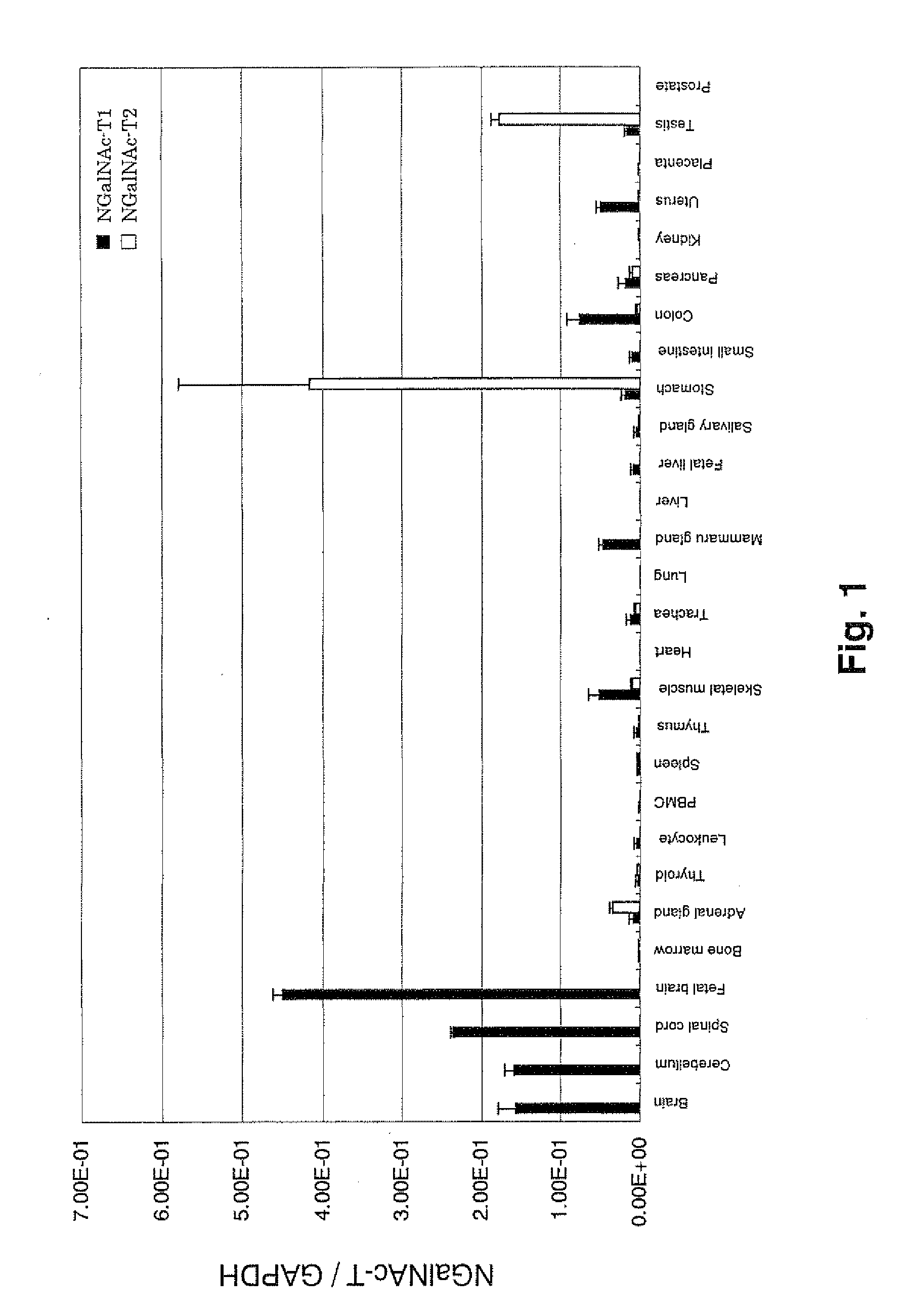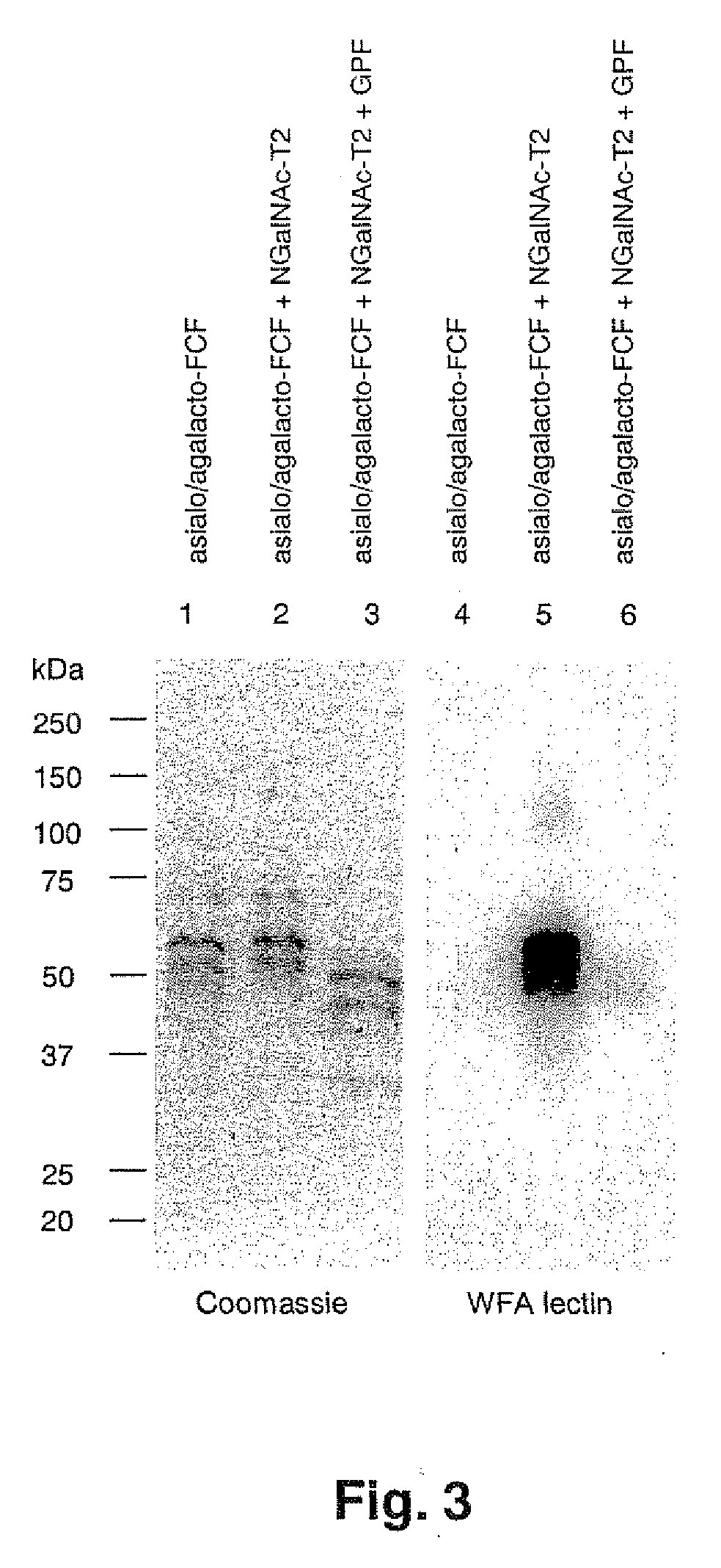Novel n-acetylgalactosamine transferases and nucleic acids encoding the same
a technology of nacetylgalactosamine and nucleic acids, which is applied in the field of new nacetylgalactosamine transferases and nucleic acids encoding the same, can solve the problems of no key isolating, no antibody against such an enzyme preparation, and difficulty in isolating and purifying proteins
- Summary
- Abstract
- Description
- Claims
- Application Information
AI Technical Summary
Benefits of technology
Problems solved by technology
Method used
Image
Examples
example 1 preparation
of the Human Protein of the Present Invention
1. Search Through a Genetic Database and Determination of The Nucleic Acid Sequence of a Novel N-Acetylgalactosamine Transferase
[0125]A search of similar genes through a genetic database was performed by use of the genes for existing β1,4-galactose transferases. The sequences used were SEQ ID NOs: AL161445, AF038660, AF038661, AF022367, AF038663, AF038664 in the genes for β-1,4-galactose transferases. The search was performed using a program such as Blast [Altschul et al., J. Mol. Biol., 215, 403-410 (1990)].
[0126]As a result, GenBank Accession No. N48738 was found as an EST sequence, and GenBank Accession No. AC006205 was found as a genome sequence. As a further result, it is considered that both sequences comprise disparate genes (hereinafter, the genes comprising N48738 and AC006205 refer to NGalNAc-T1 and NGalNAc-T2, respectively). Since the translation initiation sites of both genes were unknown, it was impossible to predict the full...
example 2
Assay of Activity Using the Enzyme of the Present Invention
1. Search for Donor Substrates
[0135]A search for a donor substrate of the enzyme of the present invention was performed on various mono-saccharide acceptor substrates, using 5 ml of enzyme solution and various acceptor substrates.
[0136]The acceptor substrates were prepared so that each of Gal-α-pNp, Gal-β-oNp, GalNAc-α-Bz, GalNAc-β-pNp, GlcNAc-α-pNp, GlcNAc-β-pNp, Glc-α-pNp, Glc-β-pNp, GlcA-β-pNp, Fuc-α-pNp, Man-α-pNp (thereinbefore, CALBIOCHEM Co.), Xyl-α-pNp, Xyl-β-pNp (thereinbefore, SIGMA Co.) was included in 2.5 nmol / 20 μl. Further, the solutions of various donor substrates (UDP-GalNAc, UDP-GlcNAc, UDP-Gal, GDP-Man, UDP-GlcA, UDP-Xyl and GDP-Fuc, thereinbefore, SIGMA Co.) are shown in Table 3.
TABLE 3GalNAc-TMES or HEPES (pH 5.5 ~50mMUDP-GalNAc0.5mMUDP-[14C]GalNAc2nCi / ulMnCl220mMTriron X-1000.5%GlcNAc-THEPES (pH 7.0 or 7.5)14mMUDP-GlcNAc0.5mMUDP-[14C]GlcNAc2nCi / ulMnCl210mMTriron CF-540.5%ATP0.75mMGal-THEPES (pH 7.0 or 7....
example 3
Expression analysis in various human tissues
[0142]The expression levels of said gene was quantified by quantitative PCR using cDNA of normal human tissues. The cDNA of normal tissues which was reversely transcribed from total RNA (CLONETECH Co.) was used. As for cell lines, total RNA therefrom was extracted, and cDNA was prepared by conventional methods and was used. The quantitative expression analysis of NGalNAc-T1 was performed using primers: K12-F3 (5′-ctg gtg gat ttc gag agc ga-3′ (SEQ ID NO: 20)) and K12-R3 (5′-tgc cgt cca gga tgt tgg-3′ (SEQ ID NO: 21)), and probe: K12-MGB3 (5′-gcg gta gag gac gcc-3′ (SEQ ID NO: 22)). The quantitative expression analysis of NGalNAc-T2 was performed using primers: K13-F3 (5′-atc gtc atc act gac tat ago agt ga-3′ (SEQ ID NO: 23)) and K13-R3 (5′-gaa tgg cat cga tga ctc cag-3′ (SEQ ID NO: 24)), and probe: K13-MGB3 (5′-ctc gtg aag gac ccg ca-3′ (SEQ ID NO: 25)). A prove with a minor groove binder (Applied Biosystems Co.) was used. Universal PCR Ma...
PUM
 Login to View More
Login to View More Abstract
Description
Claims
Application Information
 Login to View More
Login to View More - R&D
- Intellectual Property
- Life Sciences
- Materials
- Tech Scout
- Unparalleled Data Quality
- Higher Quality Content
- 60% Fewer Hallucinations
Browse by: Latest US Patents, China's latest patents, Technical Efficacy Thesaurus, Application Domain, Technology Topic, Popular Technical Reports.
© 2025 PatSnap. All rights reserved.Legal|Privacy policy|Modern Slavery Act Transparency Statement|Sitemap|About US| Contact US: help@patsnap.com



